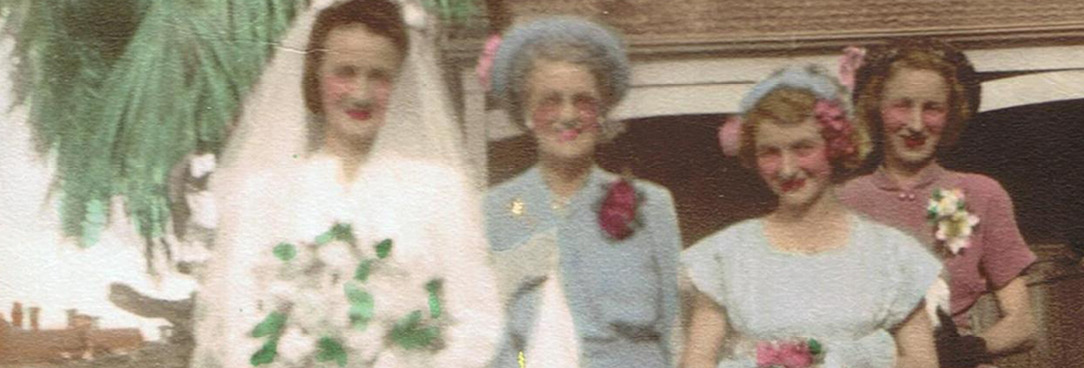Last updated:
‘Who says “you can’t change history”?’, Provenance: The Journal of Public Record Office Victoria, issue no. 14, 2015. ISSN 1832-2522. Copyright © Jacquie Browne
‘Who says you can’t change history?’ shows the intensely personal quest to break down a massive brick wall, my family history mystery of 120 years. Born in 1892 in Carlton Victoria, my Nana Beatrice McMahon nee Hughes (but actually Watson) died at 59 years never knowing her birth family. The mystery continued throughout my mum’s life of 50 years and overshadowed my life for more than 50 years until 2011. Resuming the search that my mum had started and that I shared with her before her too-early death, has allowed me to feel closer to her than ever. Added to that reconnection with my deceased mum, came a radical u-turn after my old hometown of Melbourne had progressively lost all real sense of my birth family and belonging for me over 30 years; now this extensive research has breathed new life into my hitherto jaded hometown. My childhood suburbs now had several more new addresses that connected to my family, and some other suburbs and Victorian country towns now became newly significant to my past and my present. And of course with the houses came many new relations to share with, and the opportunity for me to present them with valuable untold stories of our shared forebears. This uncovering of a huge long-lost family shows how Public Record Office Victoria (PROV) records in the last four years have contributed immensely to my research and almost single-handedly uncovered a whole family tree. The crafting was not of just the static names in their little boxes that make up the family tree graphic. Family scenarios unfolded, and were plumped up when combining various records to show different aspects of my ancestors’ lives. Cross-checking with records of other family members constructed whole family vignettes. My family history research yielded hundreds of records, often ingrained with more than a hundred years of dust. The records also showed up as multi-folded pages, often thick sheets and sometimes ‘paper thin’ like crepe paper. The folds were only annoying when it came to photographing them! PROV played such a vital role in my family history because my Watson family mystery has no family folklore passed down, no living descendants to chronicle the generations beyond my own and that of our grandparents. What surprised me when I finally met so many second, third and fourth cousins, was that I was not the only one left in the dark. Pen-inked words and old typewriting became the life-line to my large ancestral Watson family. Once I got comfortable with the peppered legal jargon of wills and probates, numerous ward registers, mental asylum records, court cases, watchhouse records and inquests, I was able to glean vital clues. Family dynamics flavoured several wills. Insights into Victorian history seeped through an often quirky turn of phrase. PROV has provided me with so much adventure and incredible surprise turns, even in connecting with other families who fostered my previously unknown great aunts. I love to share with people the vibrancy of PROV, not the staid perception that many people may have. This article is dedicated to my mum, Irene Mary Keown nee McMahon, 28 October 1930 – 16 July 1981
My beginnings: family life in the ‘burbs
I am a born and bred Melburnian. North Coburg and Fawkner were the suburbs where I grew up, and where for many years my mum and dad, my brother, my sister and I, lived, went to school, and attended church. Nearby lived assorted close family relatives in the suburbs of Essendon, Moreland, Coburg, Niddrie, Glenroy, Preston, then further away in Box Hill.[1] These were the intimately connected abodes of my known family at the time, before most of us spread our wings further afield in Melbourne, Queensland, New South Wales and Tasmania, surreptitiously eroding our cherished childhood closeness.
Winding back a generation, my mum was born and grew up in Brunswick,[2] and after she then married, spent her remaining life in North Coburg. She now ‘rests’ at Fawkner.[3] A straight line of suburbs sums up my mum’s residences.
When I moved to Frankston[4] after I married, that seemed like a faraway place. Apart from a two-year stint in Sydney, the rest of my life until now has been spent in beachside Frankston.
In 1981, my immediate birth family lived through a loss so unthinkable for any family. Both mum and dad died within two months of each other, leaving a gaping hole that no family could ever expect to fill. We three siblings became orphans at ages 25, 24 and 20.
Radical u-turn of my family life
Over the course of the decades that followed, I experienced ever-diminishing motivation to visit Melbourne and its northern suburbs. The only reason left for me to visit was for my ailing mother-in-law. Each car trip through Melbourne in the first decade of the 2000s jeered and mocked at my childhood memories of the Melbourne I had grown up in. Increasingly, I was affronted with masses of concrete structures, inner-city high-rise apartments, the likes of Ethiad Stadium, multiple blocks of gargantuan corporate facade. This was no longer my revered childhood hometown. The sense of loss neared depression, robbed of visiting my parents with eager grandkids in tow. Even visits to mum and dad’s grave at Fawkner cemetery were losing any real meaning; and though my childhood home and other relatives’ houses were and are still standing, there was no loving connection to embrace. My hometown was now bereft of any heart and loving events.
Saving Grace: Family to the Rescue
Or so I felt until late September 2011 when my cousin’s son, Brad, rang me to enlist my help with a surprise present for his dad Geoff’s upcoming seventieth birthday in November. Why me? Because my mum back in the 1970s had enthusiastically taken up the role of family historian on both sides of the family, hers and her husband’s, my dad’s. She had unearthed births, deaths and marriage certificates, land grants, inquest and probate records, the latter three from Public Record Office Victoria (PROV) which was located in the Melbourne CBD at the time. Before my mum’s death, she had infected me with the family history bug. With my drivers’ licence in hand, I joined her on several research outings to Queenscliff, Sorrento, St Kilda and Gardenvale.[5] This was my first foray into family history research. My heart happily recalls these special times with my mum. Cousin Geoff and wife Pat had come to the cousins’ reunion I had arranged in 2008, so Pat knew that I held the family treasures.
Delightedly, I assisted in putting together a family history memento for cousin Geoff’s upcoming birthday in November 2011. That day I spent with Brad in Greensborough[6] on this surprise present also produced an offer that wouldtotally change my family history, augment my memories and reignite my relationship with my erstwhile, beloved Melbourne. Brad, at day’s end, offered me temporary use of his Ancestry.com account.
Stoked, I began immediately. What astounded me was that this time, after my two, much earlier, research journeys, the playing field of family history research had been transformed so dramatically. The advent of the Internet, and the mass digitisation of records now placed so much at my fingertips.
PROV back in my life with a ‘vengeance’!
On 23 December 2011, the last day that PROV was open for that year, I found myself for the first time at their newish, you-beaut North Melbourne repository. On that day, Pandora’s box opened up and would lead me to practically set up home at the North Melbourne premises for the next two years. North Melbourne is very central and PROV has its own dedicated free car park away from the busy overpriced Melbourne CBD.
Throughout 2012 and 2013 I spent countless hours wading through very old, dust-ingrained huge, heavy volumes of ward registers,[7] court records,[8] inquests,[9] mental health asylums records,[10] as well as will and probate records.[11] I have accessed documents from the 1870s through to 2004, though the records I found for the period 1985 to 2004 were solely wills and probates. After a break from family history research for most of 2014 I resumed my visits to PROV and added new types of records.
Preamble to PROV, small achievements
My first research jaunt, that I shared with my mum, before my marriage in 1977, pertained to one particular family line, her mother’s. A complete mystery! Her mum had died back in 1951, aged 59, never knowing her birth family. The only clues we had to go on were my Nana Beatrice’s early childhood years at Queenscliff with a ‘grandmother’,[12] and then teenage years into early adulthood at the Good Shepherd Convent Oakleigh (now Chadstone shopping centre).[13] Unfortunately this shared research journey turned up empty; we did not even manage to find my Nana’s birth certificate.
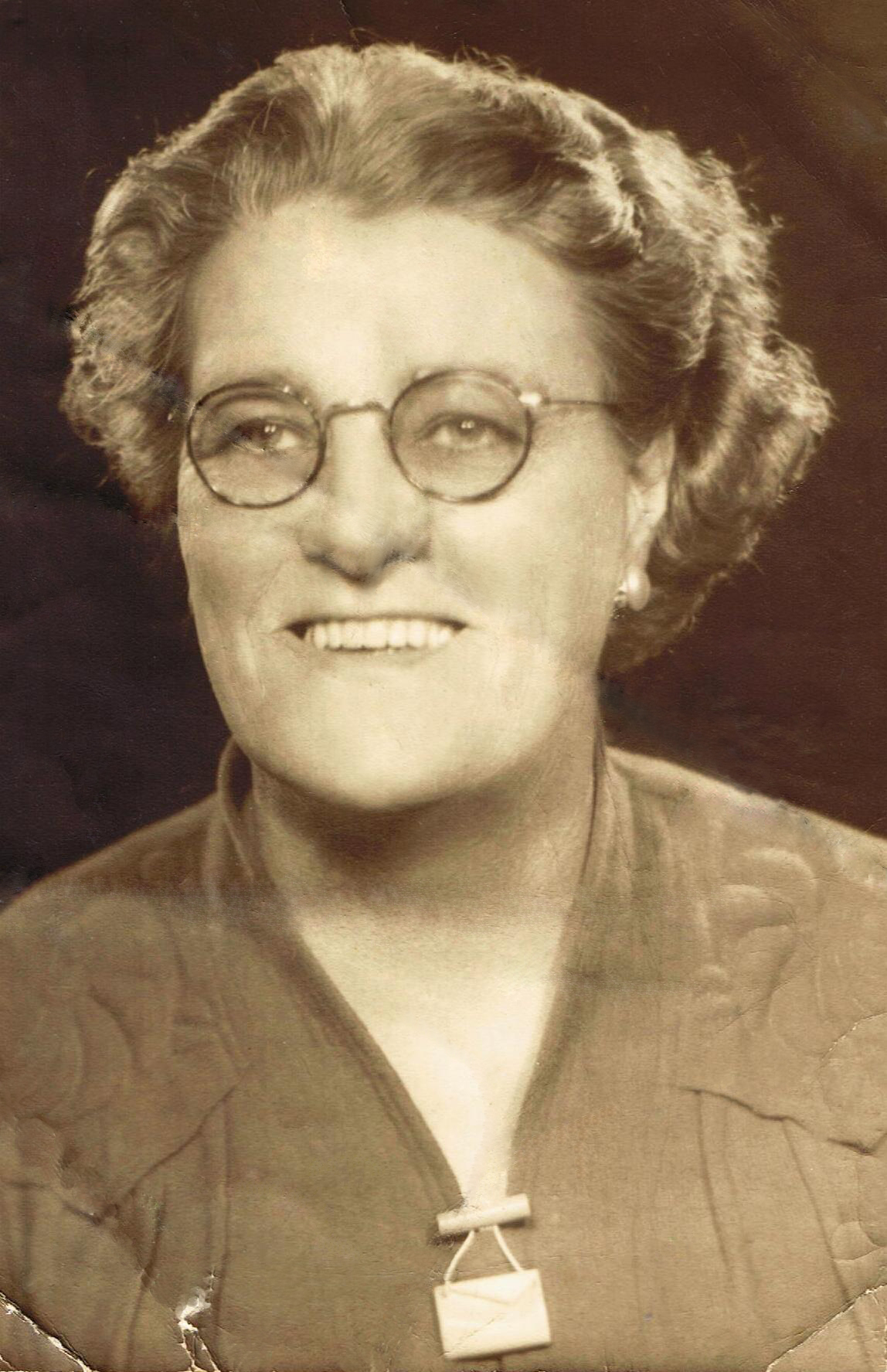
After my mum’s death in 1981, it would be five years before I started my second research journey. Initially, I managed one major breakthrough – I found Nana’s birth certificate under a different name, Lavinia Beatrice Watson, a name she never knew was hers![14] Sounds great heh? Except, that is as far as I would get in the next eight years, despite hundreds of phone calls and letters. After contacting the Good Shepherd administration of the now-defunct Oakleigh convent, their letter suggested that Nana was a state ward.[15] My mum maybe had been too close to the story, assuming certain things, never considering that her mother had been a ward. On 16 July 1986, the fifth anniversary of my mum’s death, the mail brought me a copy of Nana’s ward register entry, issued from the Department of Community Services Victoria.[16] My first ever visit to PROV later in 1986 (which was then located at Cherry Lane in Laverton) yielded a copy of Nana’s court appearance in Queenscliff.[17] The scrawled old writing in this massive volume, about 35 cm by 50 cm, was very lean on words, written with pen and ink about a tiny little girl, not yet three years-of-age: ‘Beatrice Hughes’, with comments like: ‘arrest on view’, ‘being a neglected child, having no visible means of subsistence’, ‘at Queenscliff on 13 November 1894’, ‘Committed to the Department of Neglected Children’.[18] These few words set in motion the rest of my Nana’s life, initiating her ward register record; two pages that abruptly and perfunctorily detailed her childhood all the way up to young adulthood; a past she would keep largely hidden from her three daughters. In July 1986, the year before her death in 1987, I showed this ward register to my aunty Marge, who was at that time the only surviving daughter of my Nana. Her eldest daughter, my cousin Colleen told me how her mother had cried over this ward register. These many-authored words, some conveying prejudicial overtones, recorded more than fifteen relocations and work placements with strangers, all meted out to a lonely young child and teenager. Aunty Marge cried because this record confirmed her long-held, deep gut-feeling that her mum had endured years of ‘being pushed from pillar to post’.
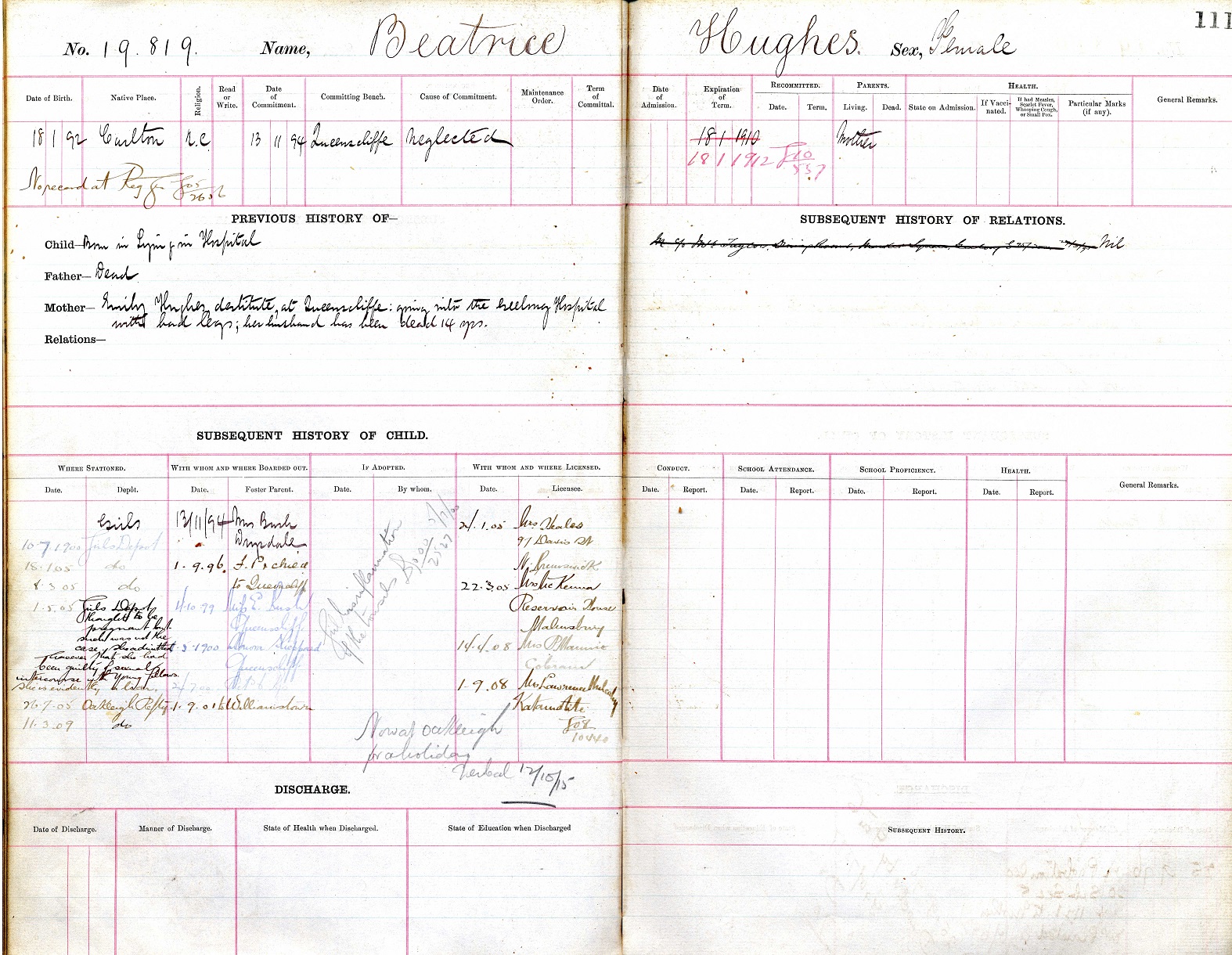
Eight years on, with no Internet as yet making records readily available online, and no funds after I gave up paid work, and a veritable ‘needle in the haystack’ with the Watson surname, I gave up the search, and got on with my life. The arrival of another baby kept me extremely busy while my other two children edged toward adulthood.
And so passed seventeen years before Brad’s surprise gift allowing me to undertake research on his Ancestry.com account. Perhaps this had been foretold by an inner whisper after my cousins’ reunion in 2008, a promise to myself; my still-intact desire to find Nana’s birth family. With that inner whisper, the image I created and promised myself was to have ‘one little old lady at our next reunion’, supposedly the next year. I imagined her as a one-and-only distant relative who would be from Nana’s birth family. No annual reunion eventuated, not in 2009 or 2010. So it was indeed wonderful to catch up with some cousins at Geoff’s seventieth birthday in November 2011.
One little old lady – yeah right!
Little did I know at the time of Geoff’s birthday, that almost exactly a year later, I would be holding another very different family reunion. This time, the participants would be overwhelmingly of new, previously unknown cousins. That fantasy of ‘one little old lady’ blew massively out in numbers. What astounded me was that those present at this Watson reunion of November 2012 represented the solution of the 120-year-old mystery, and a huge family of over 500 guestimated relatives in Australia alone, spanning at least seven generations. The truth about my Nana, who had for 120 years been this ‘little orphan Annie’,[19] and the family mystery that I was about to fully unravel, went way beyond my wildest expectations. What I found was that Nana had at least five siblings, and that her mother, Emma, was one of twelve children:– all twelve born as the family roamed through New South Wales and Victoria until they finally settled in Castlemaine.[20]
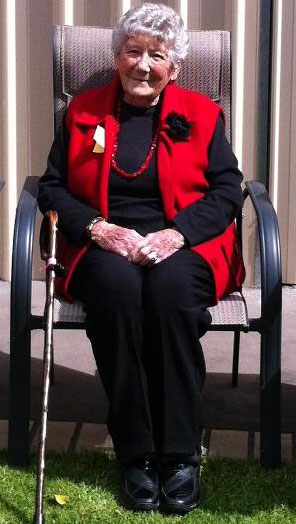
PROV you little beauty!
So what actually happened at my first visit to PROV on 23 December 2011? Via indexes and fellow researchers on Ancestry.com, I had broken through the 120-year-old brick wall. The first ancestor who enticed me to PROV, two days before Christmas, was a sister of my Nana, Laura Beatrice Hughes,[21] whom I found on an online state ward index.[22] Armed with the ward register index details, I accessed the microfiche of the original ward registers.[23] Armed also with my well-versed and exercised positive thinking, I made myself another promise, to find extra surprises somehow.
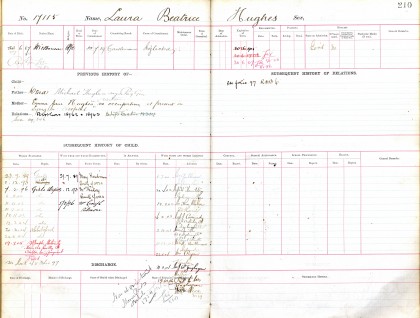
‘Somehow’ happened. The above ward register page detailed my great aunt Laura’s movements, foster parents’ names, and the suburbs and towns where she lived until she turned 13. In the ‘with whom and where licensed’ column[24] were details of names, suburbs and towns of the people for whom she worked on placements that all wards were ordered to undertake until they turned 18 years-of-age. I would later reflect on how these circumstances could have been extremely scary and harrowing; a kind of forced labour for possibly unkind people. Of my Nana’s five siblings that I have discovered, four also became wards over different years; all of them may have suffered cruelty and abuse, with no one to defend them, no right of redress. I can only guess that my Nana’s silence speaks volumes of bleak and cheerless circumstances. This is demonstrated by some particularly harsh and judgemental remarks made about her in her ward register entry on 1 May 1905, comments which probably foretold her being shipped off to the Roman Catholic Good Shepherd Convent in Oakleigh, a reformatory school for adolescents which became her new base:
Thought to be pregnant but such was not the case. She admitted however that she had been guilty of sexual intercourse with young fellows. She is evidently a liar.[25]
Though encountering comments such as this were disturbing and heart-breaking, finding details on Nana’s siblings was tremendously exciting; and still is when I hark back to the totally locked-away mystery. The extra surprises I found that day in December 2011 were impersonal references to a ‘Step Sister 18314’[26] and ‘Brothers 15942 & 15943'; these brothers then appeared in the step sister’s records (who had been assigned the ward number 18314) with their names ‘Edward & Henry Hughes’, and were noted as being ‘in the schools’.[27] Absolutely thrilled from viewing the microfiche, I then got a photocopy. Next I registered as a public user,[28] which enabled me to order and view the original records contained in huge dust-ingrained volumes. Excitedly impatient, I had to wait over the Christmas break.
So heralded the constant traipsing from Frankston to North Melbourne, weekdays and Saturdays: a mammoth task of searching and photographing thousands of pages.
A milestone, celebrating and honouring my research
On 20 April 2013, my research and my incredible story of uncovering such a huge long-lost extended family was honoured at the fortieth anniversary of PROV.[29] For two weeks a smattering of my family’s records were displayed in two glass showcases in the reading room[30] alongside family photos that were of my lifelong family: my Nana and her three daughters. Also in pride of place was a photo of the first ever Australian George & Susan (nee Malone) Watson reunion that I held on 18 November 2012.
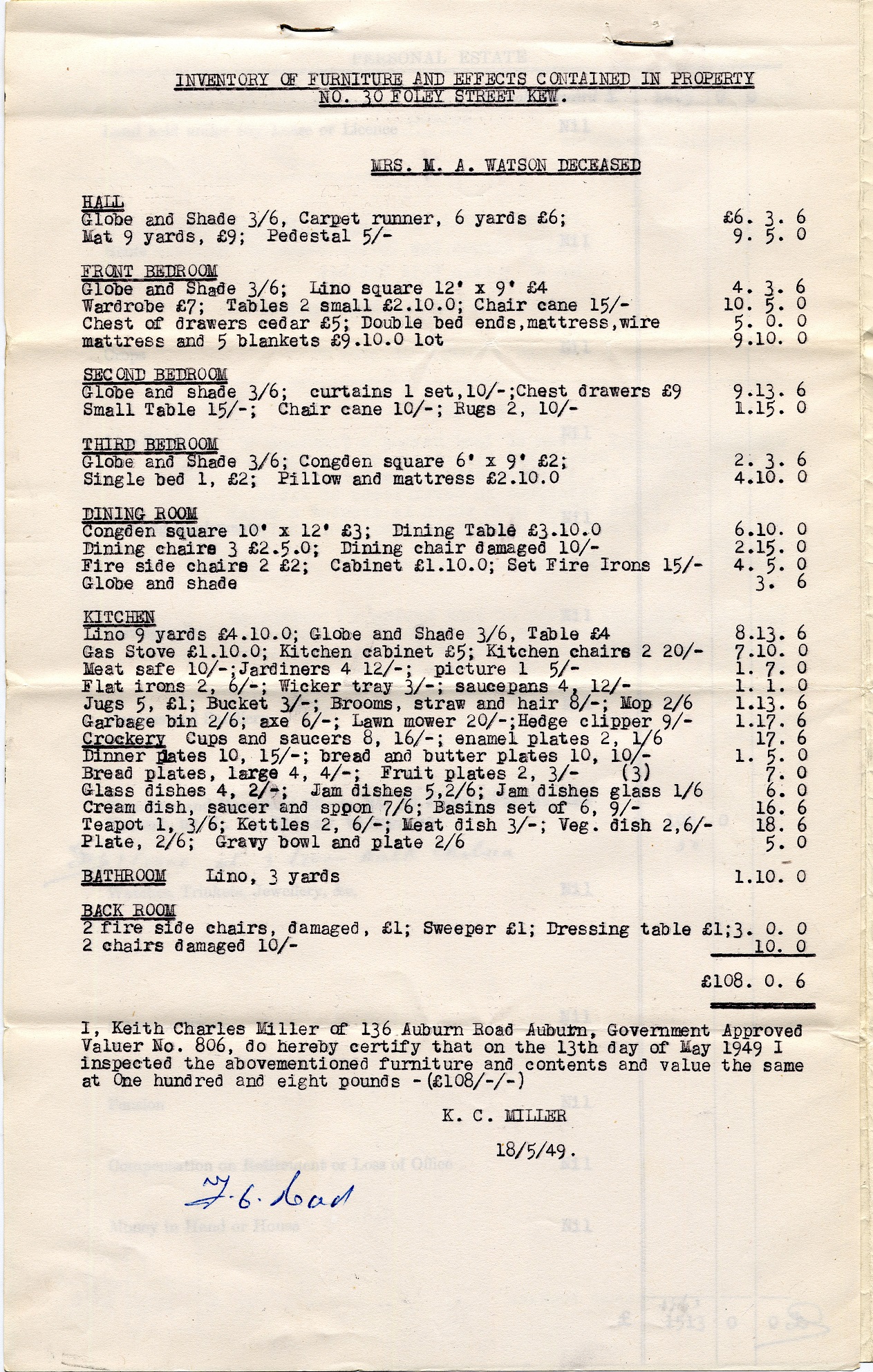
Every home should have one, a meat safe, jardiner, and congden squares. I am still researching congden, most likely a floor rug. Inventory of household contents in a 1949 probate record. PROV, VPRS 28/P3 Probate and Administration Files, Unit 4869, File 411/930.
More surprises led me to finding connections to living family members. A 1990s probate detailed a daughter’s married name; a goldmine find, especially considering her maiden surname, Watson.[31] Even more serendipitous, her married surname was quite unusual, so searching the online White Pages[32] for Victorian names proved a cinch. Contacting this cousin led me to another living cousin. This lead initially fizzled as this cousin’s online phone number was disconnected.
‘Drats!’ I lamented, has she moved?
Research can take many forms, and sometimes it pays to go the extra mile, literally. On a sunny late September Saturday in 2012, I drove to the address listed online and knocked on the door. I figured that if there was a new resident, I might get a forwarding address? ‘Drats!’ again, no-one was home.
Undeterred, I found a neighbour and enquired. Phew! I learned that she still lived there, so I left a note under the mat. Well as I expected, I was half way home when this cousin returned from walking the dog and rang me, so excited that I had found her and could tell her about her elderly father who died early in her childhood. Next day I travelled again to Rye. This 1990s probate yielded a minor miracle, as legislated privacy provisions prohibits the public access to Australian Electoral rolls after 1980 for the time being.[33]
Another time, a hunch occurred to me on 11 November 2012 which led me to a find that blew me away when I compared it with that very first 1889 record discovered on my first visit to North Melbourne. It concerned great aunty Laura Hughes. This hunch caused a 180 degree turn in how I had perceived great aunty Laura for over a year. Her ward register, started on 22 July 1889 when she was handed to the Castlemaine court,[34] contained seemingly innocent, transient 1904 and 1906 entries showing her being ‘licensed out’ to a Geoghegan family in Maffra, Gippsland. Since first seeing it in December 2011, the Geoghegan name meant little to me, just a random family Laura worked for and moved on from. Laura later married twice at age 40 and then age 60.[35] All this time I had put Laura’s records on the backburner as she had no living descendants to connect with. I already knew that she became pregnant to another worker at the Geoghegan property.[36] She had a little boy named Michael, and he too became a state ward. Sadly he died at four years-of-age.[37]
This hunch came the week before my scheduled Watson reunion. I was at the Mornington Peninsula Family History Society (MPFHS).[38] A random thought – I have come to learn that these are usually never random – I wondered if great aunty Laura had made a will? Previously, I had thought ‘no’, as she died in 1967, seemingly as an old age pensioner.[39] What the heck, I knew the microfiche of the original probate index very well, as I had already found more than thirty wills to date. Lo and behold, she had indeed made a will! A few days later, back at North Melbourne, more surprises unfolded for me. Laura willed most of her savings, engagement, wedding ring and watch to four sisters.[40] Their married names puzzled me. One sister’s address was care of Bairnsdale police station. Another sister’s name matched the name of the ‘friend’ informant on Laura’s death certificate, finally revealing the friend’s full name and gender;[41] but nothing explained how they knew Laura. Later at home, I searched the unusual married name of one of the sisters and there it was another wow moment! The index showed her maiden name.[42] It was Geoghegan, and sure enough all the sisters proved to be the Geoghegan sisters of Maffra. Once I connected the date given in Laura’s ward record for when she was ‘licenced out’ to the Geoghegan family with the birth of the first of the six Geoghegan children, the former date proved to be six weeks prior to the birth. And that first child was the informant on Laura’s death certificate![43]
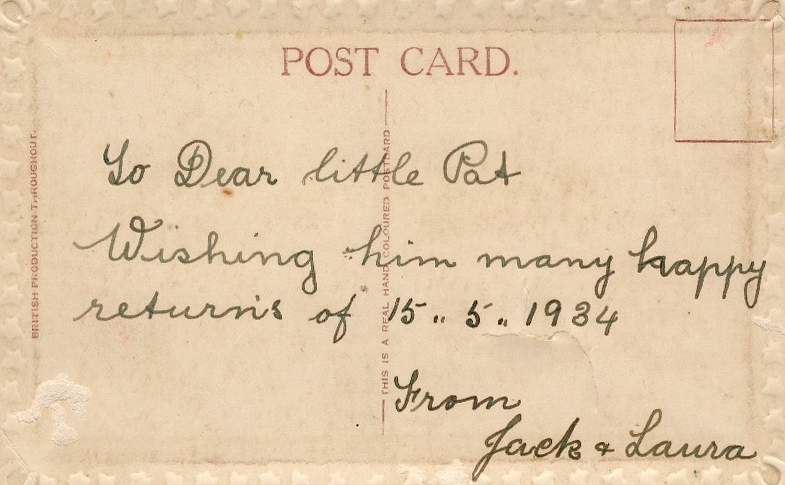
Fast forward, to and fro searching
The next step was to trace forward to find living descendants, and this led to another three probates and a sad inquest of a 19-year-old lad of the Geoghegan family.[44] His death would explain why one sister, his mother, had moved to Bairnsdale. The lad crashed his car in a head-on collision, close to where I have now lived for the last thirty years in Frankston. I have driven past the location of the accident thousands of times. The inquest’s black and white photos of the mangled cars are graphic.
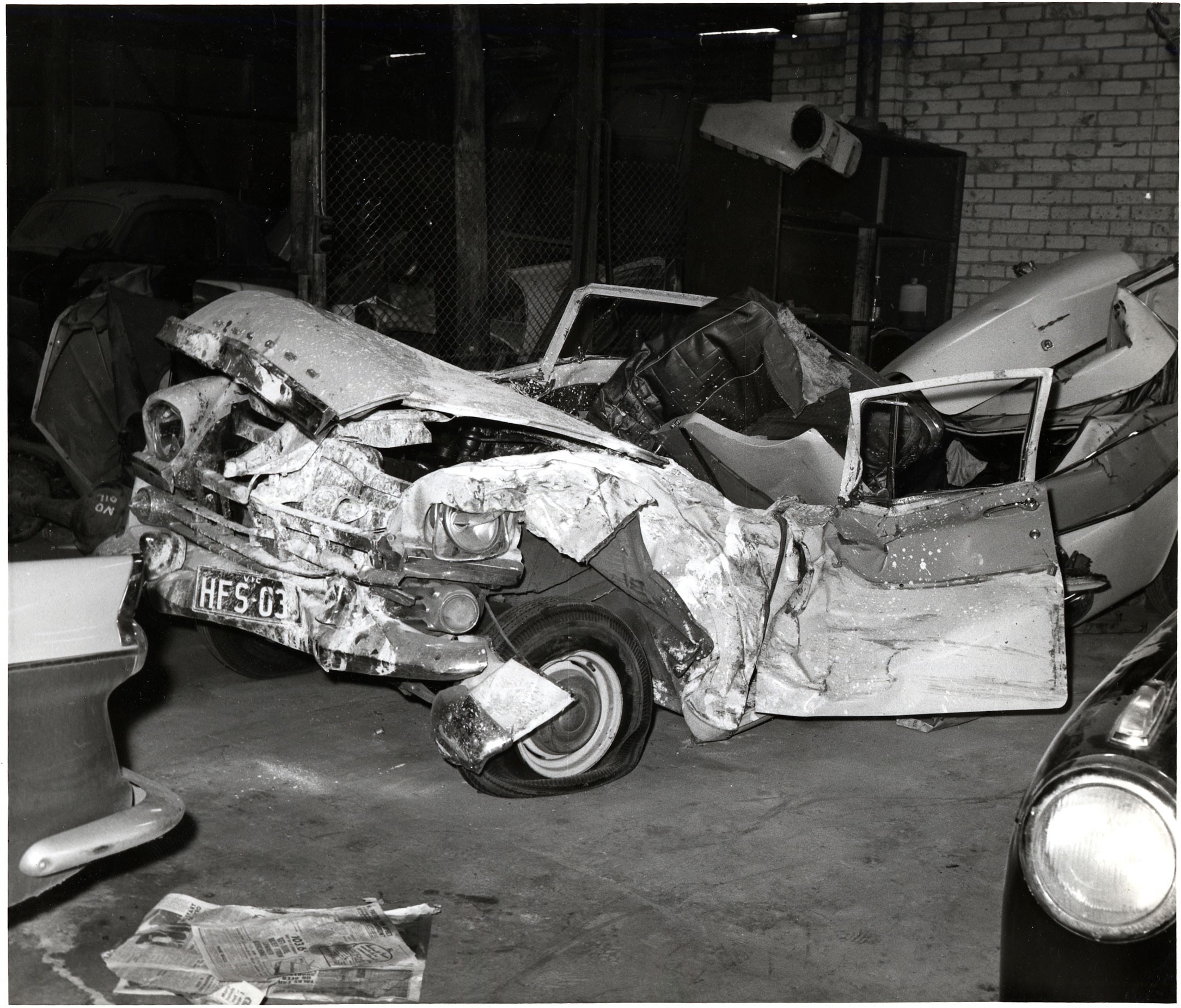
This inquest gave me greater insight into my great aunty Laura’s life, along with family recollections that would shortly materialise. Further research of this family’s probates and some people on Ancestry.com led to a day in January 2013 which I spent with a living descendant of the Geoghegan family. Wonderfully, she remembered my great aunty Laura very well. It helped that Laura had lived till 1967, sixteen years later than her younger sister, my Nana. Great aunty Laura had become a life-long loved aunt of the Geoghegan family, and for this I am so heartened and grateful. Via this ‘surrogate family’ I have a link to an ex-Queensland cricketer who ‘dismissed Steve Waugh and Michael Clarke in the space of four balls’ and ‘knocked over Simon Katich for 3-64’.[45] Knowing that great aunty Laura had such a wonderful ‘new family’ is coloured with a bitter-sweet tinge, as electoral rolls showed she had lived in the same suburb as my Nana and my mum and my two aunts.[46] She was living within 4 to 6 kms from my family. We may have met her. My mum and aunts could have used some comforting from their aunt when their mum died, especially as their dad had already taken up with another woman on the side. Furthermore, the fact that Laura died in 1967 means that I too could have grown up with her also.
Coincidence or invisible familial threads?
Further instances of close proximity of living without knowing was to occur repeatedly with many other Watson relatives. Some stunning revelations showed that my Nana and daughters had several other cousins and uncles living in the same or adjacent suburbs. With my growing up, there were also second and third cousins living nearby.[47]
There is no logical reason for such proximity. Nana’s ward register shows her birth at the Carlton ‘Lying-in’[48] Hospital, before ending up at Queenscliff with two successive foster parents (not her ‘grandmother’ as she somehow believed). Once she turned thirteen, she was off to the Girls Depot,[49] then to Brunswick, the first of many ‘licensed out’ placements. Her uncle Alfred and his children lived in Brunswick at that time. Malmsbury followed at which time she was only 20 kms away from her mum at Castlemaine. In 1918, Nana served a placement in Gippsland possibly close to her sister Laura in Maffra, who would be visiting her ‘surrogate’ family in Maffra.[50] Later came Kerang, 80 kms approximately away from Nana’s namesake aunty at Lake Marmal.[51] Finally, Nana settled with her husband and three girls in Brunswick, so close to sister Laura and uncle Alfred and several cousins. In later years, the next generations were at Coburg addresses, more ‘unknown’ cousins living close to me and my immediate family.[52]
Uncanny synchronicity and proximity occurred for me also in September 1992, when together with my husband and our two older children I holidayed at a Healesville caravan park. By this time I was six years into my second research phase; in 1994 I would throw in the towel. Enjoying the spring weather after recent floods in this area, I sat by the Badger Creek and walked along Don Road fronting the park. Nothing spectacular, you might say, until I discovered twenty years later, in October 2012, via another probate document at PROV, that one of my ‘unknown’, mystery third cousins had been living literally next door to the caravan park. He is still there today. For seven days I was within a hundred meters of this third cousin. I might have walked right past him, proffering a friendly country hello.[53]
Cross-checking begins
Laura’s ward register entry led me to a court volume detailing her handover to the Department of Neglected Children. This was a lucky find, which mirrored my Nana’s ward record and court appearance five years later. It was lucky because I did not find corresponding court reports for Nana’s other siblings. Both Laura’s and her sister’s, my Nana’s, court appearances were in country towns, Castlemaine and Queenscliff respectively. Three other siblings with ward records came before central Melbourne courts; Melbourne for the twin boys, Carlton for sister Florence; I was not able to locate corresponding court records for these children. Likewise, I was not able to find the 1874 Castlemaine court record for their mother, Emma Watson, even though this appears on her ward register entry. Interestingly, two years later I was guided to another set of records, the Castlemaine Watchhouse Charge Books.[54] This record helped me to estimate the date Emma was institutionalised and revealed more sad details. It showed that the barely 14-year-old Emma, my great grandmother, had been locked up for two days before her court appearance.
Finding my great grandmother’s ward record was a surprise, and yet somehow not totally unexpected.[55] I had been wondering why she had given up at least five of her children over many years between 1887 and 1894, especially when she had a large family of eleven siblings to support her. Her ward record showed that she was removed from her parents and siblings for three years in 1874, at the tender age of 14 years, and sent away to Abbotsford Convent of the Good Shepherd many miles from her hometown of Castlemaine. This could indicate an extreme trauma in her youth. The circumstances in which she was apprehended and brought before the Castlemaine court were very disturbing. ‘This girl was found smoking opium with a chinaman, having spent the previous night, in company with a prostitute and 4 boys’. Initially I was quite judgemental and flummoxed to read this, as my other great grandmothers were all God-fearing Irish Catholics who raised and nurtured large families. Once I recovered from the shock, I began to examine different possible explanations for my Emma’s actions. Maybe she had a fight with her siblings. Or perhaps, as the eldest daughter, she had been kept at home to help with the younger children, while her brothers were taught to read and write, and work alongside their dad in his boot-making business. Within such a constrained role, she may have rebelled, breaking out of the social norms imposed on proper female behaviour. With the discovery of Emma’s ward record, my direct Watson family line features three generations of state wards; Nana Beatrice and her siblings, and sibling Laura’s son Michael. Yet another surprise turn in solving my Nana’s birth family’s 120-year-old mystery.
Inquests: a mixed bag
Other inquests I found were filled with varied detail, depicting incredible stories of some of my Nana’s eleven uncles and aunties. Of these twelve siblings, PROV holds inquest records for four of them – three brothers and one sister. All depict varied circumstances. The first in 1889, when the youngest of the twelve, Gilbert, aged 8, was tragically trampled by a horse at the close of Castlemaine’s Saturday market day. He was taken to hospital, dying four days later.[56] Another, the oldest of the twelve, Alfred, died at 80 years-of-age at Royal Park Mental Hospital in 1937, from dementia associated with brain tumours.[57] The inquest of the sister, Lavinia Beatrice ‘Beatty’ McDonald nee Watson[58] revealed her death after eight years at Sunbury Asylum, ostensibly for mental alchohol-related causes.
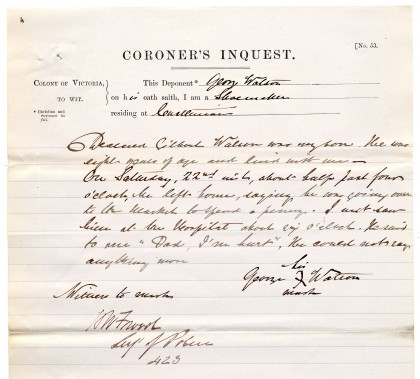
Inquests: institutional life and deaths
Finally, relieved but sad, because of his death circumstances, I have only this year, 2015, found the last remaining mystery brother, Arthur Ernest Watson. Aged 25, Arthur was delivered to Yarra Bend Asylum in 1896, because of epilepsy. A sad sign of the times when epilepsy treatment resulted in mental asylum placement. He died ten days later, after a chaotic train trip from Castlemaine to Melbourne with the escorting constable barely able to handle Arthur’s fits. Arthur fell against the train’s plate glass window, smashing it.[59]
While searching for Arthur’s mental asylum record, leafing through the files, a familiar name jumped out at me, and I chanced upon the record of a member of great aunt Laura’s first husband’s family, Agnes Treacy. Another amazing find!
I was also able to find inquest files for the next generation of my family. In addition to my great, great uncle Arthur, his brother Alfred and his sister Lavinia Beatrice McDonald nee Watson, who all ended up as ‘inmates’ of mental asylums, others from the next generation also suffered a similar fate; however, their time spent in mental asylums proved to be much longer. From the inquests I was able to discover that Nana’s twin brothers spent their teen years and the rest of their lives up until their fifties in Kew Asylum, finally dying at Ararat Mental Hospital (non-criminal wards).[60] There were moved to Ararat as Kew had for many years been grossly overcrowded, and because their removal to the country would not inconvenience any family members who would be visiting. Born the same day, they died within nineteen days of each other at the age of 57 in 1939, never having any family visit them for 44 years. My Nana never knew they existed, and perhaps nobody else in the rest of the Watson family knew either. It was because all of these family members were inmates of asylums that I was able to find inquests about them, as inquests were required for anyone who died in an asylum.
One other inquest record really stood out for me; it included four members of a family associated with my long-lost Watsons. One of the deceased was Lillian Day, the sister-in-law of one of my great, great uncles, Henry George Watson.[61] He was another uncle to my Nana. I discovered in the inquest from 1910 that Lillian, Henry’s wife’s married sister, flew into a jealous rage, set fire to her home and killed her three young children. Lillian then attempted to kill her younger sister Rose Woodward. Lilian died from a ‘wound in the throat self-inflicted with suicidal intent … whilst temporarily of unsound mind.’[62] At 11.40 pm, a witness of the unfolding tragedy, a neighbour of the Day family, was alerted to the fire and found ‘Mrs Day on top of Miss Woodward’ on the floor. They were stuggling with each other and both were hysterical. The neighbour got them both on their feet and took them out to the front of the house. He then rescued the two boys, however they later died at the Melbourne hospital. The fire brigade arrived and found Lillian’s two-year-old daughter was already dead. Lillian’s sister Rose Woodward, only twenty years old, was the only survivor. Rose testified at the inquest that she had an ‘affliction’ with limited eyesight and had been living with her sister and her family for five years. With both parents deceased, ‘the only place [she] had to fall back on for a home was Mr and Mrs Day’. On the day leading up to the fire, Rose had asked Lillian to accompany her while she sought a ‘situation’ and another place to live. Lillian asked her why she was leaving their home. Rose replied: ‘I think it is best as I have learnt to love [your] husband’. Rose stated that ‘we were friendly after the conversation and on good terms’. Before Rose went to bed at 8.35 pm, she saw Lillian writing a letter. Lillian’s husband, Bert Day, was a police constable who was at work that night. The letter was addressed to the Police Commissioner, denouncing her husband who joined the force under his brother’s name to conceal the fact that he was over age at the time of his appointment. Consequently the husband was kicked off the force, but he did marry again and have children. It must have been such a blow to my great, great uncle Henry’s wife, Maud, to so tragically lose her sister, two young nephews, a niece, and very nearly lose her other sister Rose. Barely eight years later in 1918, Maud and Henry lost their only child William in World War I. William died at the age of 21 in Montbrehain, France, on the very last day that any Australian or British battalion fought on the western front.[63]
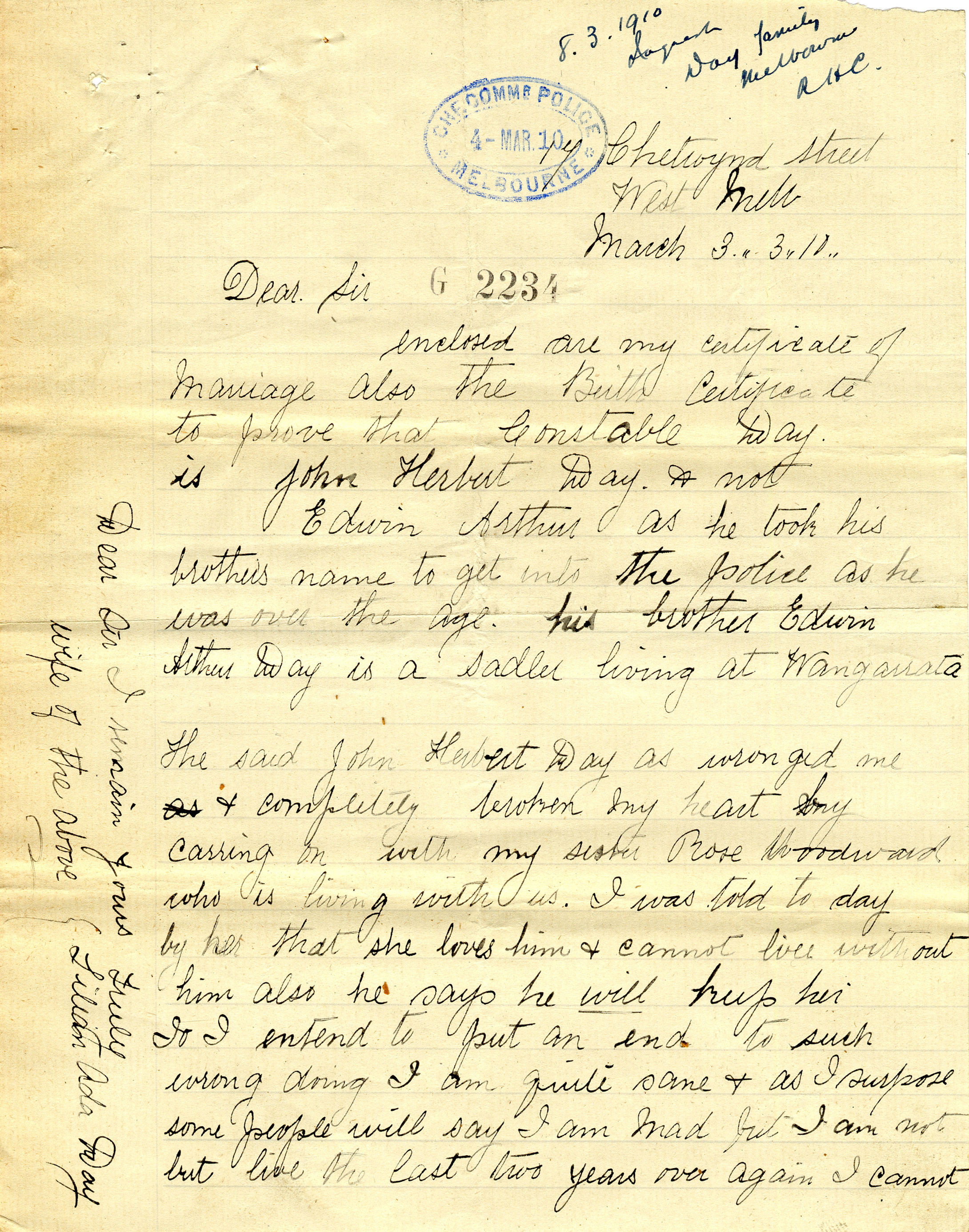
Building the jigsaw story, family comings and goings
With no family anecdotes or folklore for me to rely on, some of these records become so vital, and allowed me to cross-check dates and locales to reconstruct whole scenarios, vignettes of families interacting. We can relate young Gilbert’s inquest in Castlemaine in June 1889 with his niece Laura being handed to the Castlemaine Court one month later. Emma had been living in Collingwood and so, presumably returned for her youngest brother, Gilbert’s funeral. Laura’s ward register states that her mum Emma Jane, is ‘at present in Lying-in Hospital’ in Melbourne for her next confinement.[64]
Definite belonging
More cross-checking of records rendered vital confirmation of my Nana’s birth family. Nana’s ward register entry lists her first foster parent as Mrs Bush on 13 November 1894. Mrs Bush’s death certificate dated October 1899, shows a ‘Stoke Street Queenscliff’ address.[65] The ward record for Henry Hughes,[66] who at an initial guess, was my Nana’s brother, gives details of his mother’s whereabouts ‘M(other) c/o Mrs Bush, Stoke Street Queenscliffe 18/4/94. Same address 4/8/94’.[67] While Nana Beatrice’s ward register entry, unlike those of her siblings, makes no cross-references to her siblings, it does show her mother as being Emily Hughes. This corresponds to Henry Hughes’s ward register entry which mentions Emma Jane Hughes as his mother, living in Stoke Street at the same time.
Familiar files take me back to mum
At one time in my research journey, when I had temporarily exhausted all Watson family leads, I ordered some probates of my mum’s father’s side. Within the files I inherited from mum are records photocopied thirty years ago at the old PROV office which was located in the Melbourne CBD. When it came to unfolding and holding the original probate documents of mum’s paternal great grandfather, it proved an especially emotional moment for me; I felt a potent loving connection to mum. My guess is that maybe only one or two other relatives, if any at all, have perused them in that more than thirty-year interval, and the bridge of time between mum and myself, with this record, happily evaporated.
Renewed and new sense of family and belonging
Through these PROV records, births, deaths and marriages records, electoral rolls, Trove,[68] National Library online newspapers, cemetery indexes,[69] Mornington Peninsula Family History Society, Castlemaine Historical Society,[70] Ancestry.com, Facebook history pages and a couple of my ‘new cousins’, I now revel in a totally redefined outlook of my hitherto once-loved Melbourne. No longer tainted and jaded, no longer disenchanted, I have new connections with cousins and various houses in Coburg and Brunswick, and a totally new love for several houses and streets in South Melbourne, West Melbourne and North Melbourne, including a solid connection with the famous O’Connells Centenary Hotel, which is still standing.[71] Great aunty Laura lived there with her first husband, whose sister was the hotel licensee. Laura and her husband John probably walked the one block when they married at St Peter and St Paul’s Roman Catholic Church in 1927.[72] Castlemaine has also become so special to me, old family homes and sites, the church and historical court buildings, and the market buildings all still standing proud.
Even the Melbourne General Cemetery, which is where my Nana and Pop are buried, now has taken on so much more relevance. No longer a solitary grave there for my ‘Little Orphan Annie’ Nana; her sister Laura is buried there, and so are three uncles, an aunty, and two aunties by marriage, as well as six infant cousins. And Fawkner cemetery, where mum and dad are buried, along with two uncles, and a close neighbour, now reveals my Nana’s namesake aunt and her husband, another aunt and uncle, and several more cousins.
I have found so many second and third cousins throughout Melbourne and all over Australia, including Melbourne Queens Counsel Cliff Pannam and a connection by marriage to Lou Richards, the legendary former football player![73] Mum would have been so chuffed about Lou. When mum and dad were alive, myself, my husband and our two young ones would travel all the way from Frankston to North Coburg, for Sunday lamb roast at mum and dad’s. Lou Richards was always included! We navigated through the lounge, being serenaded by dad’s country and western songs on the radio, and into the kitchen where the roast preparation was in full swing. Presently mum would excitedly down tools and rush in to watch her beloved panel on Channel 7’s World of Sport.[74] Mum so loved the banter of Lou Richards and Jack Dyer. Wow mum, now you know you are related to Lou!
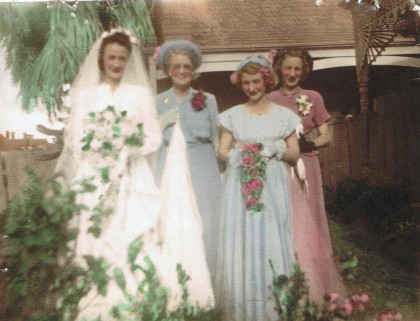
What a game changer for mum and me!
Now we have a totally ‘new’ family history with so many more lives to ponder, thanks in great part to all the records I found at PROV, which include: 41 will and probate records; one contest of will record;[75] 14 inquest files; 12 ward register entries; 7 mental asylum records; numerous court cases, 1 in Queenscliff, the rest for Castlemaine; numerous Castlemaine Watchhouse records; and 2 tramways employees records.[76]
How different is my connection to my hometown and state now. So I do declare – ‘you can change history’.
Endnotes
[1] All these suburbs except Box Hill, are northern suburbs of Melbourne. Box Hill is an eastern suburb, where two of my grandparents moved after leaving Essendon. Moreland and North Coburg are localities within the suburb of Coburg.
[2] Brunswick is another northern suburb of Melbourne, adjacent to Coburg.
[3] Fawkner is adjacent to Coburg. From Brunswick, Coburg is north of that and Fawkner is north again of Coburg.
[4] Frankston is a now a suburb situated in the southeast of Melbourne at the gateway to the Mornington Peninsula.
[5] Queenscliff and Sorrento are seaside country towns. St Kilda and Gardenvale are suburbs of Melbourne.
[6] Greensborough is a relatively new suburb on Melbourne’s northern fringe.
[7] PROV, VPRS 4527 Ward Registers (known as Children’s Registers 1864 – 1887) contain individual records kept by the Victorian Government when a child under the age of 18 was placed by a court under its stewardship. The parents were deemed to be unsuitable or unable to continue raising or supporting their child. The child was legally deemed to be a ward of the state. The Victorian government department responsible for the administration and care of such wards has been variously but not exclusively known as the: Department of Industrial and Reformatory Schools, (PROV, VA 1466, 1864–1887) and the Department for Neglected Children (PROV, VA 1467, 1887–1924). These are the timeframes my research covers.
[8] PROV, VPRS 365/P0 Court of Petty Sessions, Cause List Book, Units 6–12. PROV, VPRS 2251/P0 Court of Petty Sessions Register, Units 1–21, covering the period 1888–1927. Also see PROV, VPRS 1379/P0 Court Of Petty Sessions Cause List Book (1859 – 1878); Court Of Petty Sessions Registers (1888 – 1964), Commonwealth Cases Register (1916 – 1946), Unit 4, Petty Sessions Register Set 2 (Queenscliff).
[9] PROV, VPRS 24 Inquest Deposition Files. Only files up until 1985 are currently publicly available in this series at PROV.
[10] PROV, VA 2846 Mont Park (Hospital for the Insane 1912-1934; Mental Hospital 1934-c.1970’s; Mental/Psychiatric Hospital c.1970’s-ct), VPRS 7424 Nominal Register of Patients; VA 2840 Kew (Asylum 1871-1905; Hospital for the Insane 1905-1934; Mental Hospital 1934-c.1970’s; Mental/Psychiatric Hospital c.1970’s-1988), VPRS 7690 Nominal Register of Patients, and VPRS 7680 Register of Patients; and VA 2839 Yarra Bend (Asylum 1848-1905; Hospital for the Insane 1905-1925), VPRS 7422 Index to Male and Female Case Books.
[11] PROV, VPRS 7591 Wills and PROV, VPRS 28 Probate and Administration Files. Historically these files have been separated and are issued to researchers as separate files. Thankfully, from the 1990s they have been combined in one file format in VPRS 28. Wills and probates up to 2009 are accessible at PROV, and up to 1925 are digitised and available online. There is an index for finding will and probate files available online on the PROV website.
[12] ‘Grandmother’ was the assumed relationship of the person whom my Nana recalled as raising her as a young child in Queenscliff. Her ward register entry shows she had two foster mothers in Queenscliff. PROV, VPRS 4527/P0, Unit 43 (19692–20044), p. 111.
[13] Covent of the Good Shepherd Oakleigh was ‘established 1883 … also known as the Private Reformatory for Roman Catholic Girls’. For further information see the entry for this organisation on the Find and Connect website, available at <http://www.findandconnect.gov.au/guide/vic/E000188>, accessed 20 August 2015.
[14] Name recorded as Beatrice Hughes in her ward register entry of 1894, PROV, VPRS 4527/P0, Unit 43 (19692–20044), p. 111, my Nana was registered at birth under the name Lavinia Beatrice Watson, Federation Index, Victoria 1889-1901: Indexes to births, deaths and marriages in Victoria, Registry of Births, Deaths and Marriages, August 1997 (CD-ROM), birth registration no. 1892/2073.
[15] ‘State ward’ or ‘ward of state’ was the term used to describe a child under the guardianship of a state child welfare authority, see the Find and Connect website, available at <http://www.findandconnect.gov.au/guide/australia/FE00010>, accessed 20 August 2015. Letter to author from Sister M Frances McFaull, RGS, Assistant Archivist, Convent of the Good Shepherd, dated 22 May 1986.
[16] My Nana Beatrice Hughes’s ward register entry dated from 1894. In 1986, her record (along with the records of many other people in the same volume) was less than 100 years old and so was initially available only via freedom of information at the Department of Community Services, Victoria. After all the contents of a volume are more than 100 years old, that volume of the ward registers becomes open to the public directly via the reading room at PROV.
[17] PROV, VPRS 1379/P0 Court Of Petty Sessions Cause List Book (1859-1878); Court Of Petty Sessions Registers (1888-1964), Commonwealth Cases Register (1916-1946), Unit 4, Petty Sessions Register Set 2 (Queenscliff), p. 43.
[18] Ibid.
[19] ‘Little Orphan Annie’ is the name of a famous US comic strip, books, several movie and theatre musicals, for further information see <http://en.wikipedia.org/wiki/Little_Orphan_Annie>, accessed 20 August 2015.
[20] Castlemaine is a small city in country Victoria, in the goldfields region, about 120 kilometres northwest by road from Melbourne and about 40 kilometres from the major provincial centre of Bendigo.
[21] Laura Beatrice Hughes’s ward register entry in PROV, VPRS 4527/P0, Unit 35 (16759-17223; Girls and boys neglected. Receiving House Book Vol. RH9 [New admissions for all neglected children]), p. 210. Details of Laura’s birth,Pioneer index, Victoria 1836-1888: index to births, deaths and marriages in Victoria, Registry of Births, Deaths and Mariages, Victoria, 1998 (CD-ROM), birth registration no. 1887/17666.
[22] Victoria, Australia, Index to the Children’s Registers of State Wards, 1850-1893, is an online index I found initially on the Ancestry.com website at <http://search.ancestry.com.au/search/db.aspx?dbid=1977>, accessed 20 August 2015. The index was originally compiled by Jenny Carter and Marion Paul, Australian Institute of Genealogical Studies Inc.
[23] The great news I discovered recently is that in the last two years a great many ward registers have been digitised and are available online from PROV and easily searchable.
[24] ‘Licensed out’ refers to how the wards were administered after they turned 13 years-of-age, at which time they were no longer fostered out to women or families who were paid an allowance for the upkeep of the ward child, instead being required to work and sent where the government decreed. Usually girls were assigned as domestic servants and boys as labourers.
[25] Beatrice Hughes’s ward register entry, PROV, VPRS 4527/P0, Unit 43 (19692–20044), p. 111.
[26] ‘Step sister’ should read sister or half-sister. This ‘step’ reference confused me initially until I confirmed it was definitely a half-sister, that is, she is a sister related by blood. Step sister 18314 is a cross-reference to another child’s ward register entry, that of Florence Johnston, PROV, VPRS 4527/P0, Unit 39 (18268–18646), p. 39. Florence’s birth name was registered as Florence Adelaide Johnson, Federation Index, Victoria 1889-1901: Indexes to births, deaths and marriages in Victoria, Registry of Births, Deaths and Marriages, August 1997 (CD-ROM), birth registration no. 1889/19784.
[27] The reference to ‘industrial schools’ described in Laura’s ward register entry dated from 1889, referring to the two older brothers who were deemed as wards in 1887, is incorrect as legislation had been superseded and they should have been deemed as ‘neglected children’ or under the care of the Department of Neglected Children. ‘Brothers 15942 & 15943’ refer to the ward register numbers of Henry Hughes 15942 and Edward Hughes 15943, PROV, VPRS 4527/P0, Unit 33 (15782–16376: Girls & boys less than 6 years neglected. Girls Receiving House Book Vol. RH6 [new admissions 1887 – 27 February 1888]), pp. 77 and 78 respectively.
[28] Public user: anyone can register as public user of Public Record Office Victoria to view and research records, this can be done online at <www.prov.vic.gov.au/research>. Click on ‘Create a new user account’.
[29] PROV in its current form was established under the Public Records Act 1973, so 2013 is its 40th anniversary.
[30] The reading room is the public space at PROV in North Melbourne where all my research has been undertaken. Records are brought up to this room for the public to access. There are many other resources that are available in the reading room, for example: microfiche, microfilm, and volume sets such as the Victoria Government Gazette. Computer terminals provide access to PROV records by ordering them, as well as access to online resources such as the inquests index, plus access to Victorian births, deaths and marriage indexes, and so on.
[31] MRW will and probate 1998, PROV, VPRS 28/P28, Unit 378, Item 1151321. I have used initials to defer to the privacy of living descendants.
[32] See White Pages online, available at <http://www.whitepages.com.au>, accessed 20 August 2015.
[33] Australia, Electoral Rolls, 1903-1980, Ancestry.com, available at <http://search.ancestry.com.au/search/db.aspx?dbid=1207>, accessed 20 August 2015. There are other paid websites that provide access up to 1980. It is also possible to ask the National Library of Australia librarian online or by visiting Canberra in person. These can be accessed up to 2008. ‘Ask a librarian’ is limited to single name requests.
[34] PROV, VPRS 2251/P0 Court of Petty Sessions Register, Unit 2, 1888–1890, p. 239.
[35] Laura Beatrice Cahill, her second husband’s surname, Death Index, 1921–1985, registration no. 1967/18513, Marriage Index, marriage registration no. 1927/ 967 and no. 1947/4016, Pioneer index, Victoria 1836-1888: index to births, deaths and marriages in Victoria, Registry of Births, Deaths and Marriages, Victoria, 1998 (CD-ROM), birth registration no. 1887/17666. The birth certificate information confirms her exact age.
[36] Michael Leo Joseph Hughes, ward register number 29346, PROV, VPRS 4527/P0, Unit 71 (29250–29546), p. 97, contains the entry for Laura’s son, and states that his ‘reputed Father … was for some months in the same employ as the child’s mother’. This son is also mentioned on Laura’s ward register entry four times.
[37] Ibid. Also see Michael Leo Joseph Hughes, Edwardian Index, Victoria 1902-1913: index to births, deaths and marriages in Victoria, Registry of Births, Deaths and Mariages, Victoria, 1997, death registration no. 1909/11016.
[38] Mornington Peninsula Family History Society (MPFHS) is located at Towerhill Road in Frankston, for more information visit the MPFHS website.
[39] This is my assumption, as both her deceased husbands did not leave any will.
[40] Will of Laura Beatrice Cahill, PROV, VPRS 7591/P3, Unit 727, Item 665/310.
[41] Death certificate of Laura Beatrice Cahill quoted the informant, a ‘friend’ just as MJ Brown, death certificate no. 1967/18513.
[42] Kathleen Sparrow (married name), death certificate no. 1970/24093.
[43] Margaret Josephine Geoghegan’s actual birth date obtained from other family histories available on Ancestry.com and from living descendant of the Geoghegan family, CM, whom I visited and who had the original family bible with births listed in the front pages. For privacy reasons, I do not name the living descendant here.
[44] PROV, VPRS 24/P2 Inquest Deposition Files, Unit 45, File 1963/407, inquest into the death of PJD on 21 March 1963 at Coroner’s Court Melbourne. According to PJD’s only surviving sibling, another brother GAD was godson to my great aunty Laura. Although this is a public record, I defer to the surviving brother and cousins by using initials.
[45] ‘Joseph Henry Dawes’, available at <http://www.qldcricket.com.au/default.asp?PageID=1056>, accessed 29 March 2013. Joseph Henry Dawes, Steve Waugh, Simon Katich and Michael Clarke are current and ex- Australian cricketers.
[46] Laura Beatrice Treacy (first marriage) and Laura Beatrice Cahill’s (second marriage) address is 26 Carlton Street, Carlton, about 4 kms from her sister Beatrice at 58 Davies Street, Brunswick for the years 1936–1949. After 1949, there is a 14-year gap in the electoral rolls before Laura’s name appears again in 1963, now living at 27 Barkly Street, Brunswick, so she was living at unconfirmed times over those years between 4 and 6 kms from her sister Beatrice and daughters and then a few extra kms away from my North Coburg address from 1956. See Australia, Electoral Rolls, 1903-1980, Ancestry.com, available at <http://search.ancestry.com.au/search/db.aspx?dbid=1207>, accessed 20 August 2015.
[47] Rosina Watson died in 1951, and lived in Coburg. PROV, VPRS 7591/P2, Unit 1538, Item 441/707 and VPRS 28/P4, Unit 191, Item 441/707; Arthur Patrick Watson died in 1959, and lived in Brunswick, PROV, VPRS 7591/P3, Unit 327, Item 556/407 and VPRS 28/P4, Unit 2097, Item 556/407; Myrtle Olivia Watson died in 1965, and lived in Coburg, PROV, VPRS 7591/P3, Unit 610, Item 632/886 and VPRS 28/P4, Unit 359, Item 632/886; FC (initials to defer to privacy of a living descendant) died in 1971, and lived in Brunswick, PROV, VPRS 7591/P4, Unit 231, Item 731/646 and VPRS 28/P5, Unit 1308, Item 731/646; FC inquest PROV, VPRS 24/P2, Unit 46, File 1972/45. These aforementioned people and other cousins’ addresses also found in Australia, Electoral Rolls, 1903-1980, Ancestry.com, available at <http://search.ancestry.com.au/search/db.aspx?dbid=1207>, accessed 20 August 2015.
[48] Lying-in hospital is ‘an old childbirth practice involving a woman resting in bed for a period after giving birth’, for further information see article on Wikipedia, available at <http://en.wikipedia.org>, accessed 20 August 2015.
[49] Girls Depot (and Boys Depot), also known as ‘Royal Park Depot, in Parkville was the sole reception centre for children committed to state care from about 1880 to 1961 … a “clearing house” for boys and girls. Before they were boarded out, sent out to service or committed to a reformatory school’, see Find and Connect website, available at <www.findandconnect.gov.au/guide/vic/E000118>, accessed 20 August 2015. My Nana’s ward register entry mentions her being sent back to the Girls Depot when she was sick (inflammation of tonsils noted on 5 July 1900) from 10 to 24 July 1900 when she was returned to her second foster mother. There are three separate entries in three different columns.
[50] Gedes and Geoghegan family residences in Gippsland region were found using Australia, Electoral Rolls, 1903-1980, Ancestry.com, available at <http://search.ancestry.com.au/search/db.aspx?dbid=1207>, accessed 20 August 2015. Gedes of Gippsland, licensed out record from Good Shepherd Convent, received with archivist letters to author dated 22 May 1986 and 15 June 2012. Date for Gedes is given as both 3 March 1915 and 3 March 1918 respectively.
[51] Kerang and Lake Marmal are in the far north of Victoria.
[52] Movements in this paragraph are either from Australia, Electoral Rolls, 1903-1980, Ancestry.com, available at <http://search.ancestry.com.au/search/db.aspx?dbid=1207>, accessed 20 August 2015, or my Nana Beatrice’s and great aunt Laura’s ward register entries, PROV 4527/P0, Unit 43 (19692–20044), p. 111 and PROV, VPRS 4527/P0, Unit 35 (16759-17223; Girls and boys neglected. Receiving House Book Vol. RH9 [New admissions for all neglected children]), p. 210. The Kerang reference is from my Nana’s Great War Index, Victoria 1914-1920: index to births, deaths and marriages in Victoria, Registry of Births, Deaths and Mariages, Victoria, 1997, marriage registration no. 1920/8741. The latter record was first obtained by my mum Irene Keown nee McMahon circa 20 January 1978.
[53] PCH will and probate, 1992, PROV, VPRS 28/P22, Unit 25, Item 1050030, which shows her surviving son’s address as Don Road, Healesville (initials used in deference to privacy of living descendants).
[54] Details of my great grandmother Emma Watson appear in PROV, VPRS, 1444/P0 Watchhouse Charge Books, Unit 7, Item 52, p. 4. I also accessed Units 6–13, finding several entries for my great, great grandfather and a few mentions of his sons.
[55] Emma Watson, ward number 7492, PROV, VPRS 4527/P0, Unit 15, p. 53. This information was located in a separate section sewn into the back of this volume, which is why I initially had trouble finding the original record. Nicole Llewellyn, a PROV staff member at the time in December 2012, located it for me after I mentioned the concept of sewing together different volumes.
[56] Gilbert Watson inquest 27 June 1889 at Castlemaine Court, PROV, VPRS 24/P0, Unit 548, File 1889/849.
[57] Alfred Joseph Watson inquest 30 April 1937 at Royal Park Mental Hospital, PROV, VPRS 24/P0, Unit 1330, File 1937/628.
[58] Lavina Beatrice MacDonald inquest 8 May 1947 at Melbourne Morgue, PROV, VPRS 24/P0, Unit 1564, File 1947/655. Lavinia Beatrice Watson was born 1878 in Castlemaine, Pioneer index, Victoria 1836-1888: index to births, deaths and marriages in Victoria, Registry of Births, Deaths and Mariages, Victoria, 1998 (CD-ROM), birth registration no 1878/14399. The ‘old sheilah’ Valma Gibbons (my second cousin, once removed) was born in 1924 and remembers Lavinia as aunty Beatty (actually her great aunt Beatty, sister to her Nana Florence). Lavinia Beatrice Watson is also the namesake of my Nana, her niece.
[59] Arthur Ernest Watson, PROV VA 2839 Yarra Bend (Asylum 1848 – 1905; Hospital for the Insane 1905 – 1925), VPRS 7399/P1 Case Books of Male Patients, 1896 – 1898, Unit 11, p. 1; Arthur Ernest Watson inquest 25 February 1896 at Yarra Bend Mental Asylum, PROV, VPRS 24/P0, Unit 655, File 1896/279; Bendigo Advertiser, Tuesday, 25 February 1896, p. 3.
[60] Henry Hughes died 19 April 1939 at Ararat Mental Hospital according to the inquest into his death, PROV, VPRS 24/P0, Unit 1374, File 1939/504. Edward Hughes died 8 May 1939 at Ararat Mental Hospital according to the inquest into his death dated 9 May 1939, PROV, VPRS 24/P0, Unit 1375, File 1939/587.
[61] Henry George Watson, Pioneer index, Victoria 1836-1888: index to births, deaths and marriages in Victoria, Registry of Births, Deaths and Mariages, Victoria, 1998 (CD-ROM), birth registration no 1873/15174. Henry was honoured by his eldest sister, Emma Jane, my great grandmother, who named one of her twins after him. She also did this with the other twin Edward Albert, who was named after another brother. She also named my Nana after Lavinia Beatrice, as she did with two other daughters, Susan Matilda and Florence Adelaide. This pattern helped me irrevocably confirm this Castlemaine Watson family as my Nana’s birth family. Only Laura Beatrice’s naming was somewhat different, perhaps because Emma had lost her partner five months before Laura was born, and maybe the name was to honour him somehow. Her partner Michael Hughes remained special to Emma the rest of her life as she kept his surname, even though she obviously had other partners.
[62] Lilian Ada Burfield Day, Herbert Roy Day, Charles Cyril Day, Violet Lilian Day inquests 8 March 1910 held at the Melbourne Morgue, PROV, VPRS 24/P0, Unit 850, File 1910/154.
[63] William Martin Watson, rank of private, was killed in action, aged 21 on 5 October 1918 at Montbrehain France, after 3 years fighting, NAA: B2455, WATSON W M, available online at <http://recordsearch.naa.gov.au/SearchNRetrieve/Interface/ViewImage.aspx?B=1915548>, accessed 20 August 2015. There is information about the 21st Australian Infantry Battalion on the Australia War Memorial website, available at <https://www.awm.gov.au/unit/U51461/>, accessed 20 August 2015, see also AR McNeil, The story of the Twenty-First: being the official history of the 21st Battalion, A.I.F., 21st Battalion Association, Melbourne, 1920.
[64] Confinement is the term that was once used to refer to the condition of a woman in childbirth.
[65] Mary Bush, Nana’s first ‘boarding out’ foster mother, who died 4 October 1899 at Stoke Street Queenscliff, Federation Index, Victoria 1889-1901: Indexes to births, deaths and marriages in Victoria, Registry of Births, Deaths and Marriages, August 1997 (CD-ROM), death registration no. 1899/15703,
[66] Henry Hughes, my Nana Beatrice’s brother ward register entry, PROV, VPRS 4527/P0, Unit 33, p. 77. His twin brother Edward Hughes’s entry is on p. 78.
[67] Queenscliff(e) is a small town on the Bellarine Peninsula in southern Victoria, Australia.
[68] Trove is a collection of online resources hosted by the National Library Australia, which includes an invaluable digitised collection of Australian newspapers.
[69] For example, Greater Melbourne Cemeteries Trust Deceased Search, available at <www.gmct.com.au/deceased-search.aspx>, accessed 20 August 2015, Springvale Botanical Cemetery Deceased Search, available at <https://sbc.smct.org.au/deceasedsearch/>, accessed 20 August 2015, Melbourne General Cemetery is planning to have its deceased search facility online soon.
[70] Castlemaine Historical Society Inc (CHSI), for further information visit their website.
[71] Some of the homes are only a block or two away from Public Record Office Victoria in North Melbourne, such as homes in Canning and Dryburgh streets, using information obtained in Australia, Electoral Rolls, 1903-1980, Ancestry.com, available at <http://search.ancestry.com.au/search/db.aspx?dbid=1207>, accessed 20 August 2015.
[72] St Peter and St Paul Roman Catholic Church, corner of Montague and Dorcas streets, South Melbourne. Laura’s first marriage, Marriage Index, marriage registration no. 1927/967.
[73] Clifford Leslie Pannam QC is my second cousin once removed. Lou Richards’s mum’s maiden name was Pannam. Lou is connected to my mum and myself by marriage. My great, great aunt Alice Maud Watson married Robert Constantine Pannam in 1891, Federation Index, Victoria 1889-1901: Indexes to births, deaths and marriages in Victoria, Registry of Births, Deaths and Marriages, August 1997 (CD-ROM), marriage registration no.1891/1555.
[74] World of Sport aired on Melbourne’s television Channel 7 weekly for 28 years before its final airing in 1987.
[75] LAW (initials used in deference to privacy of only surviving grandson) v Reginald Rupert Gray (as executor of the will and estate Arthur Patrick Watson), PROV, VPRS 267/P5 Civil Case FIles, Unit 80, Item 1960/4407.
[76] For Carl Anton Woess, see PROV, VPRS 12738/P1 Tramways Employees Record Book, Unit 5, p. 630, and for George Theodore Watson, see PROV, VPRS 12738/P2, Unit 6, p. 223.
Material in the Public Record Office Victoria archival collection contains words and descriptions that reflect attitudes and government policies at different times which may be insensitive and upsetting
Aboriginal and Torres Strait Islander Peoples should be aware the collection and website may contain images, voices and names of deceased persons.
PROV provides advice to researchers wishing to access, publish or re-use records about Aboriginal Peoples
